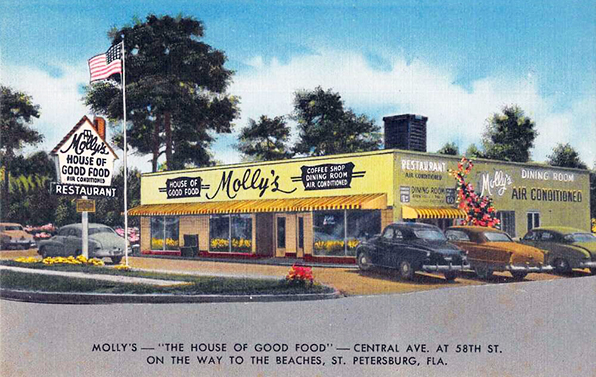Lincoln L. Loper already had more than 25 years in the restaurant business under his belt—first in Milwaukee, then in Seattle, and then in several different cities in Iowa—when, in 1950, he and his wife, Florence, moved to St. Petersburg, Florida, bought a brand-new building at the corner of Central Avenue and 58th Street, remodeled it for their purposes, and opened Molly’s Restaurant.
The Lopers billed their restaurant as the “House of Good Food”—the legend emblazoned above the awning and on the big sign out front—as well as “The Best Place in Town to Eat Full Course Dinners.” The restaurant offered table, counter, and booth service, and customers could get their fill of comfort food at Molly’s without spending a lot of money. Weekday plate lunches, for example, were just 60 cents. Complete Sunday dinners ranged in price from $1.15 for “Fried Snapper Fingers” to $2.50 for a “Grilled Large T-Bone Steak”—served with chicken noodle soup or tomato or papaya juice, a combination salad with French dressing, and homemade rolls and butter—with a half-dozen other entrees in between. And in 1956 diners at Molly’s could get a full Thanksgiving dinner—roast turkey, roast Long Island duckling, or prime rib with soup or salad, side dishes, dessert, and beverage—for just $1.94.
In 1959 Loper bought a 100-acre of virgin land in western Brazil on the advice of his brother-in-law, who’d seen the tract while living in Sao Paolo. “He said the soil was rich and the climate was perfect,” Loper told a reporter for the St. Petersburg Times., adding that his grandfather had traveled west in a covered wagon during the California Gold Rush. “My wife and I plan to visit our ranch next summer. If we like it we may buy more and perhaps settle there.”
But Brazil, at least for the Lopers was not to be. In 1960 they announced that they had sold the building at 5756 Central Avenue to the I.C. Helmly Furniture Company, and Molly’s Restaurant closed on September 30 of that year. Lincoln Loper died in St. Petersburg in 1973 at age 79.

Ambrosia Chiffon Pie
This pie was one of the most popular desserts at Molly's Restaurant in St. Petersburg, Florida. Recipes for "ambrosia chiffon pies" were first appeared in the 1930s, and in time endless variations were introduced with such added ingredients as grapes, marshmallows, pineapple, and maraschino cherries. Florence Loper, who owned Molly's Restaurant with her husband, Lincoln, used this recipe up until the time they closed the restaurant in 1960.
Ingredients
- 1 3-ounce package orange-flavored gelatin
- 1 cup boiling water
- 1/4 teaspoon salt
- 3 large eggs, separated
- 3/4 cup granulated sugar, divided
- 3/4 cup orange juice
- 2 tablespoons lemon juice
- 1/2 cup shredded coconut, divided
- 1 9-inch baked pie shell
- Whipped cream, for topping (optional)
Instructions
In a medium bowl, add the boiling water to the gelatin and stir until the gelatin is fully dissolved. Add the salt.
Place a double boiler over medium heat and bring water to a simmer. Put the egg yolks and 1/2 cup of the sugar in the top part of double boiler and whisk until combined. Cook, stirring or whisking constantly, until the mixture thickens. Remove from heat and add the orange and lemon juice. Cool in refrigerator until partly set.
In a large metal or glass bowl, beat the egg whites with a hand mixer on medium-low speed until the whites are broken up and frothy, about 20 seconds. Increase the speed to medium-high and continue to beat until the whites are foamy and opaque, about 30 seconds, then gradually add the remaining 4 tablespoons of sugar in a slow, steady stream, beating constantly. Once all the sugar is added, continue to beat just until you have dense, glossy egg whites that hold a stiff peak.
Fold the beaten egg whites into the cooled gelatin mixture. Stir in 1/4 cup of the shredded coconut and pour into the baked pie shell. Sprinkle the remaining coconut over the top of the pie. Refrigerate.
Lightly sweetened whipped cream may be spread over the top of the pie when served.
Notes
This original recipe from Molly's Restaurant included uncooked egg whites. If you're wary of using raw eggs in recipes, consider buying in-shell, pasteurized eggs instead.










No Comments